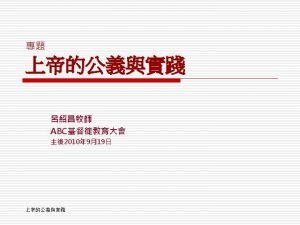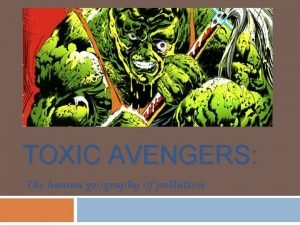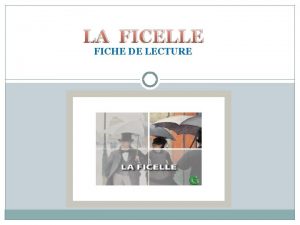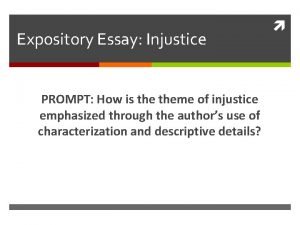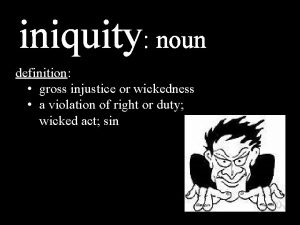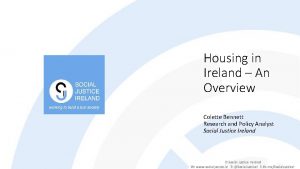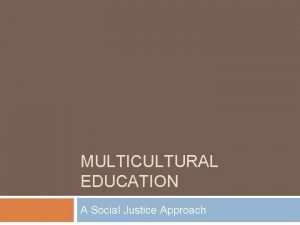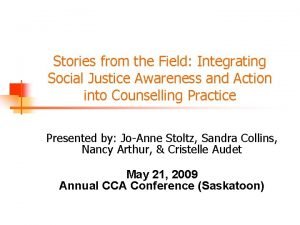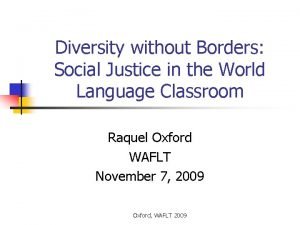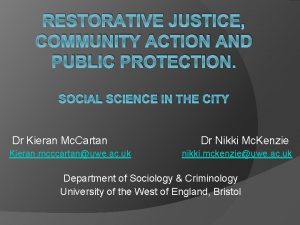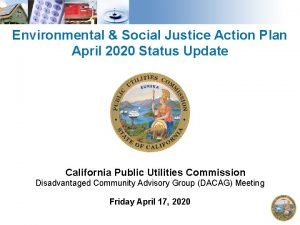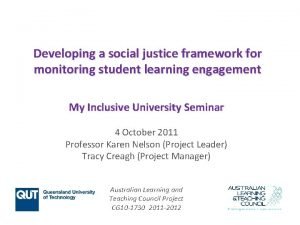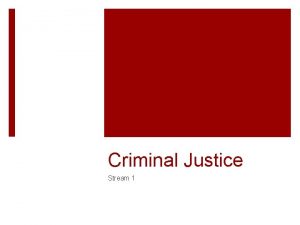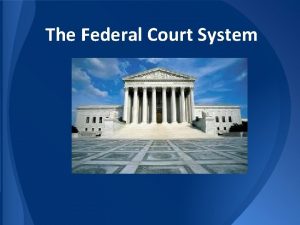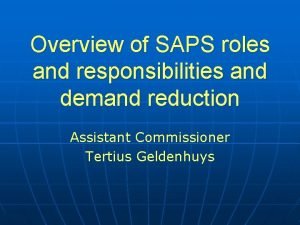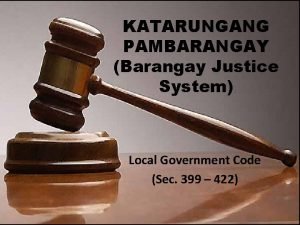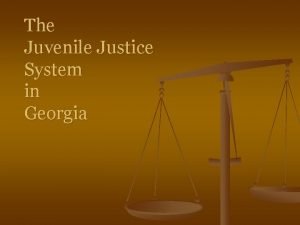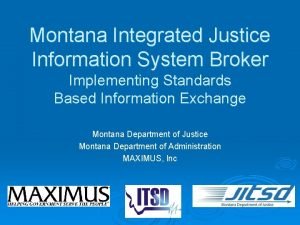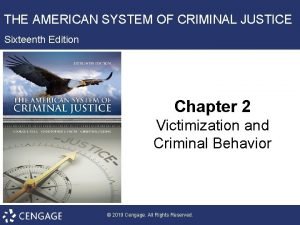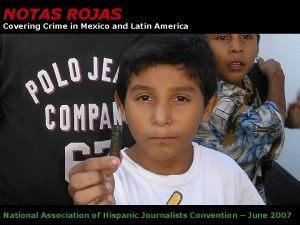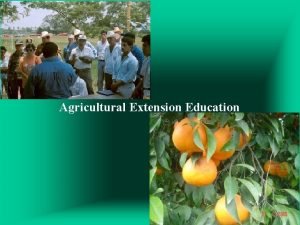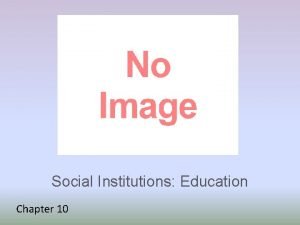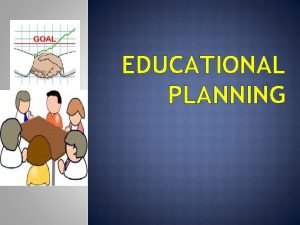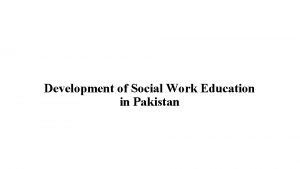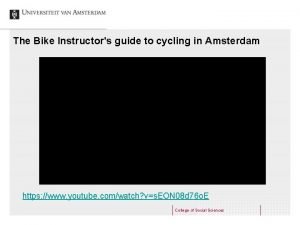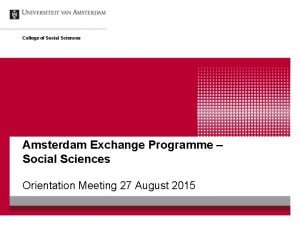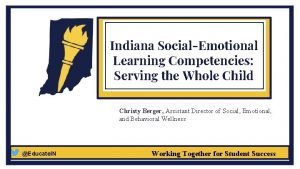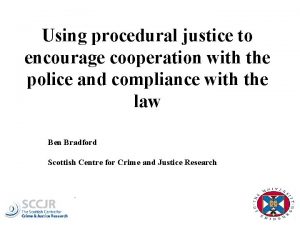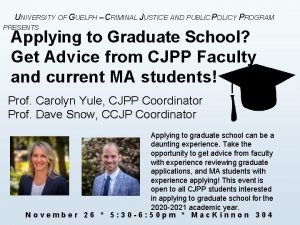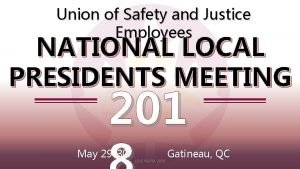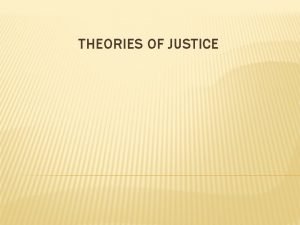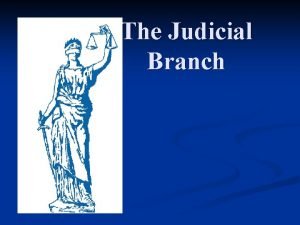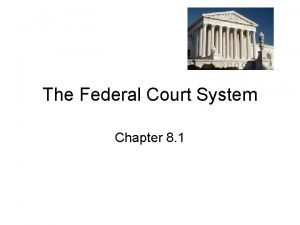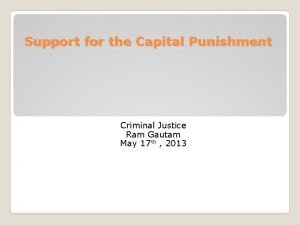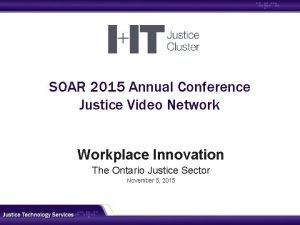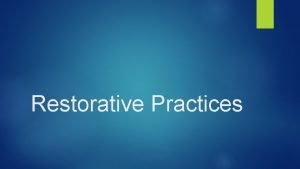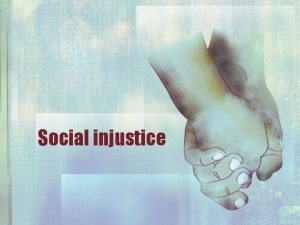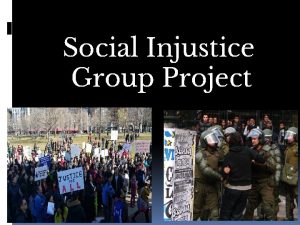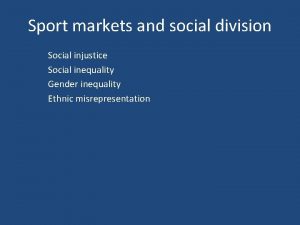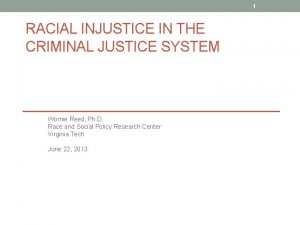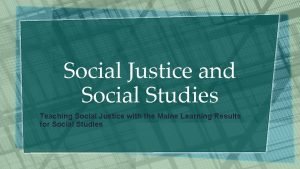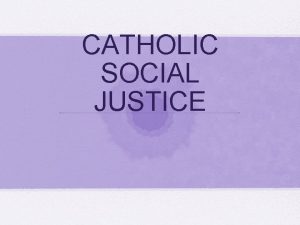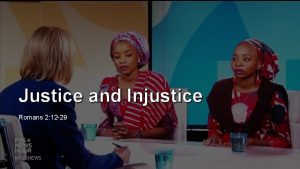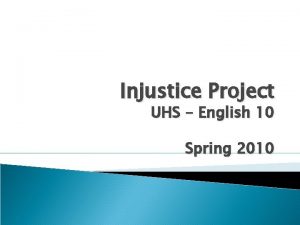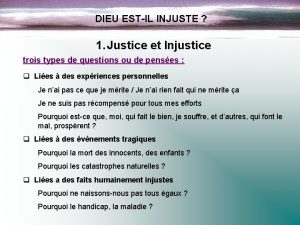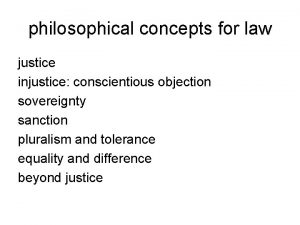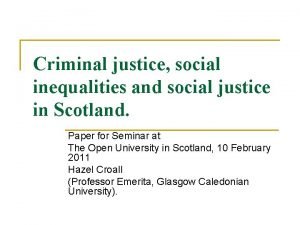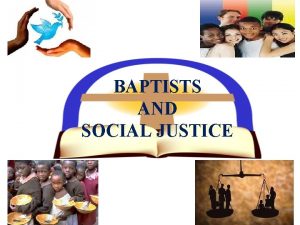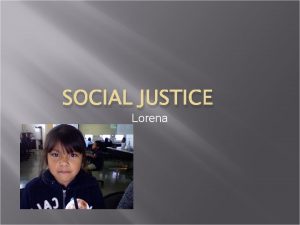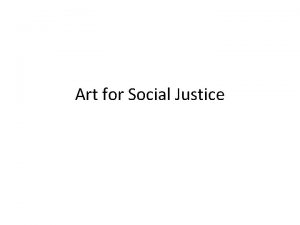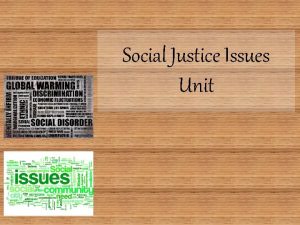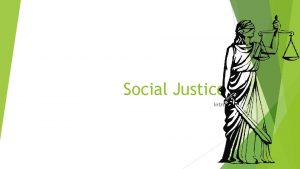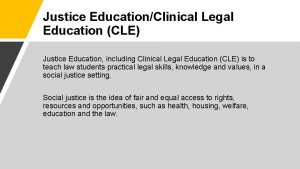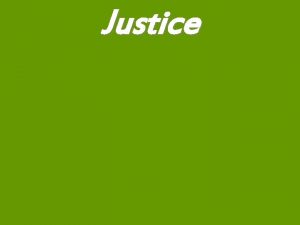SOCIAL JUSTICE OR INJUSTICE IN EDUCATION SYSTEM IN
























































- Slides: 56

SOCIAL JUSTICE OR INJUSTICE IN EDUCATION SYSTEM IN 6 DIFFERENTS COUNTRIES, Access and quality Luis Fernando Aranguren

Why education? 1. “Everybody has right to education 2. Education shall be directed to the full development of human personality and to the strengthening of respect for human rights and fundamental freedoms 3. It shall promote understanding, tolerance and friendship among all nations, racial or religious groups, and shall further the activities of the United Nations for the maintenance of peace” (art. 26 - Universal Declaration of Human Rights)

BUT? § ACCESS & QUALITY § Access: – Gender issues – School available, – Free education – Public & private education – Library – Internet and other media – Availability of all possible majors

§ Quality: – Not only literacy and numeracy – Making the teacher training consistent – Traditional system methods – Improve new methodologies – Comparison of different teaching system – Degree comparables with foreign universities

Colombia

Colombia • • Gender Issues: (Since +/- 30 years ago. The same right School available: – Basic and middle school: • Public: free • Private: expensive 70%* 30%* – Superior education • Public: cheap, • Private: Expensive • * ** 30% public universities * 70% private universities * Literacy rate • Women: • Men: • good quality 92%** 91%** Library and Internet: Main cities: small cities or villages: free access. Not access. Source: Ministry of education. www. mineducacion. gov. co Source: CIA www. cia. gov

Colombia Basic and media education students Coverage rates National coverage Year students Coverage rate Source: Colombian education minister

Colombia Superior education students Coverage rates National coverage Year students Coverage rate Source: Colombian education ministry

Social Justice in Thailand: Educational Access and Quality Wasan Chantong DVM, MSc (Ph. D student)

The Structure of the Thai Education System Pre-primary education (Three years) Primary education (Six years) Lower-secondary education (Three years) Upper-secondary education (Three years) Higher education (Four years for Bachelor’s degree)

Educational System and Network Central: Ministry of Education Network: public and private institutions Neighboring countries: Lao PDR and Cambodia School atmosphere

Access 1: Educational Opportunity • Gender issues – both Thai male and female are provided equal opportunity to access to life-long education and training • Disabilities – Provide public education to the disabled, the handicapped and the under-privileged. Girl-guides and crippled boy scouts stand hand in hand during their gathering.

Access 2: Education Technology System and Information Network • H. R. H. Princess Maha Chakri Sirindhorn has always paid special attention to education for young people. • Increase and disperse the opportunities for education for all Thais in both urban and rural areas. – Tele-education (Thai-com satellite) – Television set – Computer and internet

Access 3: Availability • Universities and Community Colleges – 65 public and private universities and colleges – 17 institutions are community colleges • 150 other educational institutions – offering various vocational degrees • Classroom atmosphere

Quality 1: Literacy • Currently according to UNDP, the literacy rate in Thailand is 92. 6 per cent – male: 94. 9% – female: 90. 5% (www. cia. gov, retrieved July 26, 2006) • Need to develop more

Quality 2: Teachers • High-quality teachers and educators – basic ethical requirements – 5 -year-course Bachelor’s degree in Education – Professional certificate – High salary • Inadequate number of quality teachers and financial supports

Quality 3: Tradition and new methodology • Traditional system methods – the integration of education, religion, culture and sports into the educational and training curriculum • Improvement of new methodology – the integrative learning process – the "learner-centered approach“ – self-education and life-long education

Quality 4: knowledge-based society • On-going access; need time to measure the quality – Power of creativity – A love of reading – Sufficient community-based libraries, learning centers and educational media

Jorge Pintor

General Background Primary and Secondary School University The Gitano Case

Primary and Secondary School § Most government-funded/Private institutions § Usually good (though not excellent)

University § Fees (Usually Low) § Good students with good marks don’t pay if they apply for government grants

The Gitano Case (i) § § § 650. 000 gitanos 1. 6% of the population According to Alfagueme y Martínez, (2004):

The Gitano Case (ii) Idiosyncrasy of the family Society/Racism

The Gitano Case (iii) Fundación Secretariado General Gitano (1994): 36% of the Gitano students do not attend lessons

Social Justice in Brazil : Educational Access and Quality Cristiano C. Nunes

Social Justice: Educational System in Brazil Primary Education ? Secondary Education Higher Education Access and/or Quality…

Access • Gender issues • Compulsory • Schools available • Free education • Public and private

Primary and Secondary School • Important Characteristics – Public x Private – 1990’s http: //web. worldbank. org/WBSITE/EXTERNAL/COUNTRIES/LACEXT/BRAZILEXTN /0, , menu. PK: 322351~page. PK: 141132~pi. PK: 141107~the. Site. PK: 322341, 00. html – Meals – Library • Higher Education ?

Higher Education – General Characteristics • Expansion during 1990’s • Different organizations – – Federal State Municipal Private – Federal University

Universidade Federal de Viçosa - UFV • Undergraduate Courses • Graduate Courses • Library http: //www. ufv. br/proplan/ufvnumeros/numeros 2005. pdf

Education and Social Justice in Iraq Dena K. Mohammad M. A. American Studies


Access to Education § Free Education – Free education from elementary to high school – Some state universities provide free education – Private universities are not free § Availability of Majors – Certain fields of study are not available in universities

§ Libraries – City libraries are free and available in the three major cities across Iraq – Access to library services is free in schools and universities – Sources and materials are generally old publications / lack of up-to-date materials – Access to internet and media services is strict and limited


Quality of Education § Access and quality do not go hand in hand – Serious deterioration in recent years – Private education do not promise quality – Absence of social justice in all educational institutes § Role of Teachers and Professors – Education is strictly teacher-centered – Serious cases of corruption – Teaching methods are out-of-date

§ Challenges to Education – Successive Wars/Aftermath – Stressful security situation – Financial difficulties/Drop-outs

Iraqi school girls talk to USAID education advisors in a classroom of the Agadir Secondary school in the Saydiya neighborhood of Baghdad. USAID is looking at ways of updating the Iraqi school curriculum § Attempts at Recovery – Assistance and recovery programs § USAID Assistance for Iraq § UNESCO programs – Recovery requires community work to back these programs up


Islamic Republic of Afghanistan

Education and Discrimination n Before 1979, Russian Invasion Access to education was low n Education centered only in big cities like Kabul, Kandahar, Heart, Mazar e Sharif n Only the families related to the king had the right of education and higher education n Students were mostly boys n The quality of Education was good and was comparable to other countries n

After Bonn conference in 2001 n Learning strategy n Article 45 of Afghanistan constitution: states develop unified curriculum based on Islamic principle n National culture n Based on scientific methods n n Religious subjects based on branches of Islam

n Access to the education is very high and successful 1500000 children went to school in 2004 as well as 2005 n All children will be at schools by 2015 n n Equity education for girls and boys Schools are open for both girls and boys in urban and rural areas n according to article 44 of Afghanistan Constitution the state is responsible to develop education all over the country for both girls and boys n

n Quality has become a high priority because the quantity is on a regular and satisfactory progress n The Quality is improving by: Curriculum development n New textbooks in our national languages ( farsi and pashtoo) n Teacher education programs n

n Content of education Development of culture of peace n Respect for human rights n National and international understanding n Brotherhood n Forgiveness n Reconstruction of Afghanistan n Safeguarding its territorial integrity and Independence n

Literacy CIA - the World Fact Book


CONCLUSIONS • WE HAVE SEEN differences and similarities among countries (multiples perspectives) • WE CAN LEARN from each other’s experiences and educational systems • WE MUST find ways to improve education all over the world

Potential obstacles • Political corruption • Ambition and egoism • Indifference • War

United Nations role • Second UN Millennium Development Goal (to 2015): ACHIEVE UNIVERSAL PRIMARY EDUCATION: Ensure that all boys and girls complete a full course of primary schooling. • NEXT STEP: REAL POLITICAL DECISION (NOT ONLY DECLARATIVE) AND, ABOVE ALL, $$$.

… United Nations role "We will have time to reach the Millennium Development Goals – worldwide and in most, or even all, individual countries – but only if we break with business as usual. We cannot win overnight. Success will require sustained action across the entire decade between now and the deadline. It takes time to train the teachers, nurses and engineers; to build the roads, schools and hospitals; to grow the small and large businesses able to create the jobs and income needed. So we must start now. And we must more than double global development assistance over the next few years. Nothing less will help to achieve the Goals. " United Nations Secretary-General Kofi A. Annan

Fulbright role • We, as Fulbright Fellows, are direct witness of the great work that Fulbright does to improve education around the world. • Fulbright gives brilliant students from all over the world (LIKE US) the opportunity to complete the “last step” in our education process. • Also, with its competitive system, Fulbright pushes young students to make a great career in order to be eligible in the future.

Our role “With great power come great responsibilities” Spiderman (2002) Please, note the quotation, so do not accuse us of plagiarism.

… Our role • We can change that phrase and say “With great education comes great responsibilities” Alonso (2006) –please do not plagiarize the phrase-, and make the compromise to work in favor of our countries, as politicians, volunteers, educators, investigators, business man, etc.

… Our role • We have received this great opportunity, and we are in debt to the world.
 Injustice anywhere is a threat to justice everywhere essay
Injustice anywhere is a threat to justice everywhere essay After death in hinduism
After death in hinduism Environmental injustice definition ap human geography
Environmental injustice definition ap human geography L'injustice sociale dans la ficelle
L'injustice sociale dans la ficelle Example of expository paragraph about family
Example of expository paragraph about family Fusha e futbollit vizatim
Fusha e futbollit vizatim Expulsion
Expulsion Colette bennett
Colette bennett Definiton of dignity
Definiton of dignity Social justice approach
Social justice approach Ottawa charter pdhpe
Ottawa charter pdhpe Social justice awareness
Social justice awareness Teaching tolerance
Teaching tolerance Restorative justice community action
Restorative justice community action Cpuc environmental and social justice action plan
Cpuc environmental and social justice action plan Principle of social justice
Principle of social justice Social thinking adalah
Social thinking adalah Social thinking social influence social relations
Social thinking social influence social relations Four pillars of criminal justice system
Four pillars of criminal justice system Supreme court justice system
Supreme court justice system Arizona criminal justice information system
Arizona criminal justice information system Responsibilities and functions of saps
Responsibilities and functions of saps Katarungang panlipunan
Katarungang panlipunan Georgia juvenile justice system
Georgia juvenile justice system Criminal justice wedding cake diagram
Criminal justice wedding cake diagram Ra. 9344
Ra. 9344 Integrated justice system
Integrated justice system The american system of criminal justice 16th edition
The american system of criminal justice 16th edition Notas rojas
Notas rojas Juvenile justice system in georgia
Juvenile justice system in georgia Minnesota juvenile justice system
Minnesota juvenile justice system How formal education differ from als
How formal education differ from als Different between health education and health promotion
Different between health education and health promotion Extension education is non formal education
Extension education is non formal education Explain the social impact of ict
Explain the social impact of ict Latent functions of family
Latent functions of family Define educational planning
Define educational planning Social work education in pakistan
Social work education in pakistan Education desk social sciences uva
Education desk social sciences uva Education desk social sciences
Education desk social sciences Indiana department of education social emotional learning
Indiana department of education social emotional learning Is the earth an open or closed system?
Is the earth an open or closed system? Digestive system circulatory system and respiratory system
Digestive system circulatory system and respiratory system Distributive justice definition
Distributive justice definition Procedure justice
Procedure justice University of guelph criminal justice and public policy
University of guelph criminal justice and public policy Union of safety and justice employees
Union of safety and justice employees Theories of justice
Theories of justice The illusion of justice in the tempest
The illusion of justice in the tempest Lady justice blindfold meaning
Lady justice blindfold meaning Court
Court Justice for jenny
Justice for jenny Retributive justice examples
Retributive justice examples State of connecticut division of criminal justice
State of connecticut division of criminal justice Justice video network
Justice video network Retributive justice examples
Retributive justice examples Retributive justice examples
Retributive justice examples
